An international team of researchers, led by University of Leicester planetary astronomer Tom Stallard, has detected a localized region of cooling — dubbed the ‘Great Cold Spot’ — in the upper atmosphere of Jupiter.
The Great Cold Spot (GCS) has been observed as a dark spot in Jupiter’s high-altitude thermosphere.
It is comparable in scale to the famous Great Red Spot, measuring up to 24,000 km in longitude and 12,000 km in latitude, and is approximately 200 degrees Kelvin cooler than the surrounding atmosphere, which can range in temperature between 700 degrees Kelvin (426 degrees Celsius) and 1,000 degrees Kelvin (726 degrees Celsius).
The GCS is thought to be caused by the effects of Jupiter’s magnetic field, with polar auroras driving energy into the atmosphere in the form of heat flowing around the gas giant.
This creates a region of cooling in the planet’s thermosphere, the boundary layer between the underlying atmosphere and the vacuum of space.
Although the astronomers aren’t sure what drives this weather feature, a sustained cooling is very likely to drive a massive storm system similar to the Great Red Spot.
“This is the first time any weather feature in Jupiter’s upper atmosphere has been observed away from the planet’s bright auroras,” said Dr. Stallard, lead author of a paper in the journal Geophysical Research Letters describing the discovery.
“The GCS is much more volatile than the slowly changing Great Red Spot, changing dramatically in shape and size over only a few days and weeks, but it has re-appeared for as long as we have data to search for it, for over 15 years.”
“That suggests that it continually reforms itself, and as a result it might be as old as the auroras that form it — perhaps many thousands of years old.”

The Great Cold Spot was first discovered on Jupiter using observations taken of Jupiter’s auroral region by the CRIRES instrument on ESO’s Very Large Telescope. The images on the left show the bright arcs of Jupiter’s infrared aurora on two separate nights, the top left image on October 17 and three images taken December 31, 2012, as the planet slowly rotates. However, the Great Cold Spot cannot be seen clearly until these images are saturated so that the entire aurora becomes white, as shown on the right. Here, the planet glows as a result of the temperature of the upper atmosphere, and the distinct regions of cooling that reveal the Great Cold Spot can be seen. Image credit: Stallard et al / ESO.
Dr. Stallard and co-authors used the CRIRES instrument on ESO’s Very Large Telescope to observe spectral emissions of H3+, an ion of hydrogen present in large amounts in Jupiter’s atmosphere, which allowed the team to map the mean temperature and density of the planet’s atmosphere.
They then used images of H3+ emission from Jupiter’s ionosphere taken by NASA’s InfraRed Telescope Facility between 1995-2000 to compare.
Through combining images taken over a period of time, they revealed the presence of the GCS as an area of darkness amongst the hot environment of Jupiter’s upper atmosphere.
“The detection of the GCS was a real surprise to us,” Dr. Stallard said, “but there are indications that other features might also exist in Jupiter’s upper atmosphere.”
“Our next step will be to look for other features in the upper atmosphere, as well as investigating the GCS itself in more detail.”
_____
Tom S. Stallard et al. The Great Cold Spot in Jupiter’s upper atmosphere. Geophysical Research Letters, published online April 10, 2017; doi: 10.1002/2016GL071956








